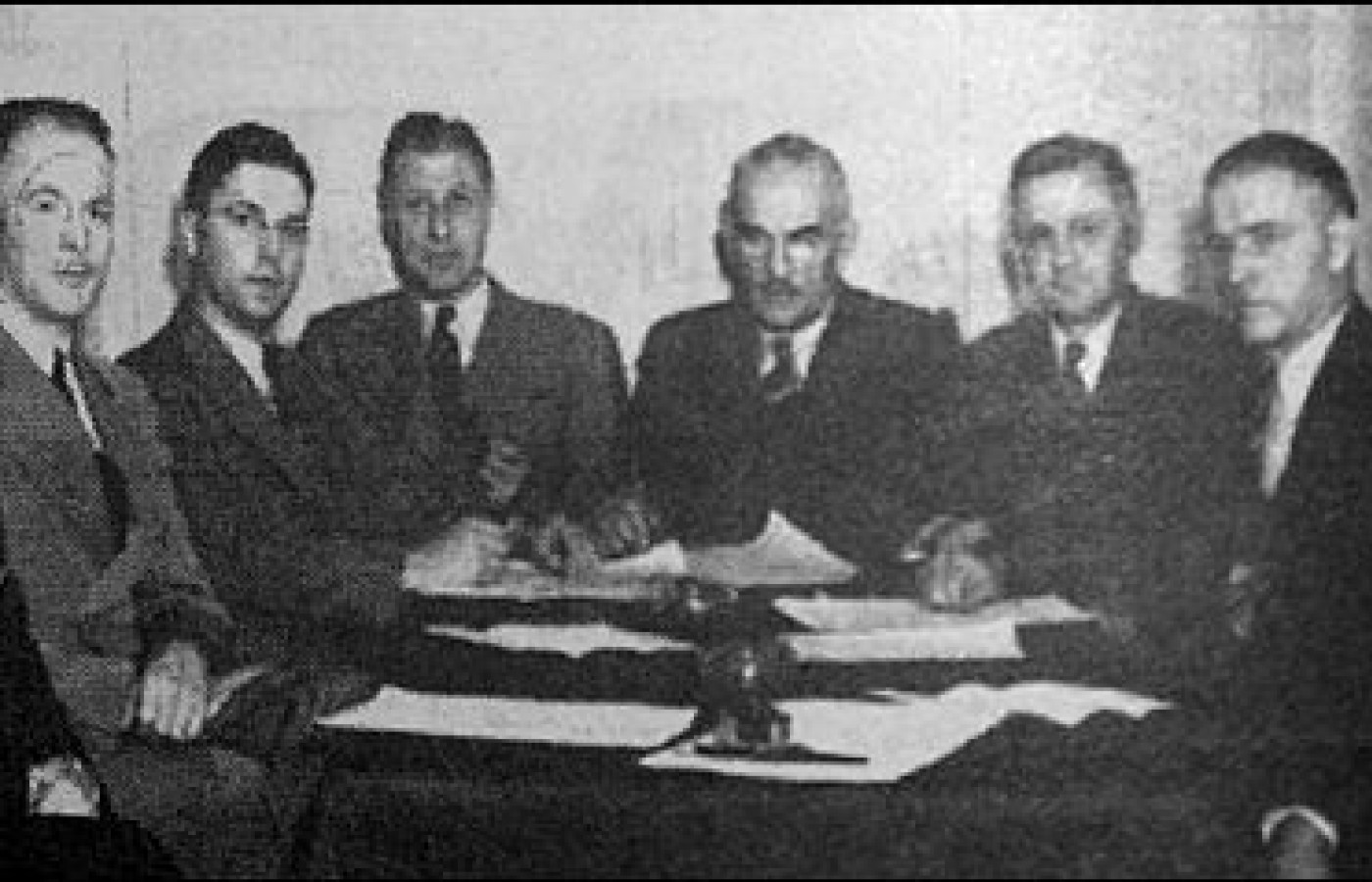This article focuses on nine severe injuries that are generally not diagnosable until the third to fourth week following the date of injury, including how to diagnose these severe injuries. The discovery of any of these injuries early can make a significant difference in the case outcome.
| Digital ExclusiveBirth of the CMCC
This year the Canadian Memorial Chiropractic College (CMCC) is celebrating its golden anniversary and enjoying international recognition as one of the strongest academic institutions in the profession. Today, secure in its identity and anticipating an even stronger academic future in its university affiliation, the College stands as a model for other institutions to emulate. But it was not always so. Fifty years ago the fate of the still unborn school was uncertain. Its conception and development are a credit firstly to the chiropractors of Canada, but also to the educational reform efforts of the National Chiropractic Association (NCA).
The CMCC began as a dream in the minds of two men: Walter T. Sturdy, D.C. of British Columbia and John S. Clubine, D.C. of Ontario. Clubine, a co-founder and the former dean of the Toronto College of Chiropractic (1920-1926), practiced in Ontario for 25 years, and served as president of the Ontario Chiropractic Association in 1936 (Rehm, 1980, p. 302). In 1938, as Ontario's representative to the NCA, he had been instrumental in inspiring the D.D. Palmer Memorial in the founder's birthplace, Port Perry, Ontario along the shores of Lake Scugog. Sturdy, a 1919 Palmer graduate, is recalled as the prime mover in obtaining British Columbia's 1934 chiropractic law, and served as president of the province's chiropractic association from 1920 until 1934. Sturdy is also remembered as the driving force in the creation of the Dominion Council of Canadian Chiropractors (DCCC), forerunner of today's Canadian Chiropractic Association. Sutherland (1993) relates that Sturdy dispatched his son-in-law, attorney John S. Burton, on a nationwide tour in order "to roundup support within the profession for a national organization that would have representation from each province, regardless of whether a province's members favoured the 'straight' or 'mixer' point of view."
The seminal meeting of the DCCC took place in Ottawa during January 10-11, 1943 (see Figure 1). Sturdy was elected the DCCC's first president, with Clubine as secretary and John A. Schnick, D.C. of Ontario, who had served as the NCA's president during 1938-39, as vice-president. Impetus for the organization was the Canadian Parliament's impending legislation for national health insurance (which was not passed), the lack of licensure for chiropractors in all but three of the nation's provinces (Alberta, British Columbia and Ontario), and the profession's desire to acquire commissioned officer status in the wartime military. However, by October, 1943, when the DCCC convened in Toronto for its second meeting, the issue of dwindling numbers of Canadian practitioners had been added to the society's concerns. At the time there were only 418 DCs in the nation (Sutherland, 1993), nearly half of whom were located in Ontario. Since the three or four chiropractic colleges that had once operated in Ontario (Biggs, 1989) were no longer functioning, the profession's only option to maintain itself was to send prospective students to the United States or establish a new chiropractic college in Canada.

Figure 1: photo taken in Ottawa on January 11, 1943, and appearing in the National Chiropractic Journal 1943 (March); 12(3): 27; original caption read: "Pictured above are Directors of the recently organized Dominion Chiropractic council, representing all Provinces in Canada. (Left to Right) Dr. Gaudet, Montreal; Dr. Haldeman, Regina; J.S. Burton, Vancouver; Dr. J.A. Schnick, Hamilton; Dr. Sturdy, Vancouver; Dr. J.S. Clubine, Toronto; Dr. McElrea, Winnipeg; Dr. Messenger, Calgary."
In later years attorney Burton would recall Sturdy's initial effort, at the 1943 meeting in Ottawa, to promote a Canadian school:
After long hours of strenuous meetings, Dr. Sturdy awakened me at 6:00 o'clock on the final morning with the startling announcement that we must start a college in Canada, and without delay. Now without delay means, in Dr. Sturdy's language, a matter of hours, and while I attempted to catch up on long lost sleep I was forced to listen for one hour or more while Dr. Sturdy outlined his plans for a future college (McNeil, undated).The planning process would consume Sturdy, Clubine and the DCCC for nearly two years. According to Brown (1990):
To facilitate the process of establishing a school, on January 3, 1945, the Dominion council formed a separate body under the Corporations Act of the Province of Ontario, called the Canadian Association of Chiropractors, which later became the charter of CMCC. On January 31, 1945, at the first meeting of the Directors of this College Association, Dr. [Herbert K.] Lee was elected Secretary/Treasurer of both the College Association and its Financial Organization Committee...Financing the new institution would be only one of the many formidable problems the planning body would confront. The issue of curriculum would be contested repeatedly during this formative period (1943-45) by the various provincial delegates to the DCCC and the school's governing board (Keating & Haldeman, 1995). Representatives from Ontario and the eastern provinces argued for a broad-scope program of instruction, including diagnosis, in-depth basic sciences and physiotherapeutics. Moreover, instruction in "mixer" methods was essential for those graduates of the new school who wished to obtain licensure in Ontario, since the licensing law required such training, and the examining body in that province was a composite board of chiropractic, naturopathic and other drugless healers. Doctors from the western provinces, most of whom were Palmer graduates, argued strenuously for a "straight" curriculum, and against instruction in physiotherapy. The founders also disagreed about the extent of influence that the DCCC should exert over the proposed college and about whether the school should be non-profit.
However, the group agreed to abide by majority rule, and also that policies related to chiropractic in Canada should not be governed by American foibles and gurus. Eventually, it was agreed that physiotherapy instruction sufficient to qualify graduates for licensure in Ontario would be provided in optional, post-graduate modules provided at the end of the proposed four-year curriculum (see Table 1).
| Table 1: "Four Year Schedule at the Canadian Memorial Chiropractic College (Dedicatory, 1947) | |
| Hours | |
| Freshman Year - First Semester | |
| Anatomy I. (Osteology and Arthrology) | 90 |
| Embryology (Development Anatomy) | 90 |
| Chemistry I. (Inorganic-general) | 90 |
| Physiology I. (Nerve and Muscle) | 90 |
| Lexicology | 45 |
| Principles and Theory of Chiropractic | 45 |
| 450 | |
| Second Semester | |
| Anatomy II. (Myology) | 90 |
| Histology | 90 |
| Chemistry II. (Organic) | 90 |
| Physiology II. (Digestion and Metabolism) | 90 |
| Palpation I | 45 |
| Principles and Theory of Chiropractic | 45 |
| 450 | |
| Sophomore Year - Third Semester | |
| Anatomy III. (Splanchnology) | 90 |
| Chemistry III. (Physiological) | 90 |
| Physiology III. (Special Senses) | 90 |
| Bacteriology I. (General) | 90 |
| Palpation II. | 45 |
| X-Ray Physics and Technique | 45 |
| 450 | |
| Fourth Semester | |
| Anatomy IV. (Angiology) | 90 |
| Chemistry IV. (Pathological) | 90 |
| Physiology IV. (Neurological) | 90 |
| Bacteriology II. (Special) | 45 |
| Pathology I. (General) | 45 |
| Technique (Chiropractic) | 90 |
| 450 | |
| Junior Year - Fifth Semester | |
| Anatomy V. (Central Nervous System) | 90 |
| Pathology II. (Systemic) | 90 |
| Hygiene, Sanitation and Public Health I. | 90 |
| Diagnosis I. | 90 |
| Physical Diagnosis | 45 |
| Dietetics | 45 |
| First Aid and Toxicology | 45 |
| Technique (Chiropractic) | 45 |
| 540 | |
| Sixth Semester | |
| Anatomy VI. (Peripheral Nervous System) | 90 |
| Pathology III. (Systemic) | 90 |
| Diagnosis II. | 90 |
| Hygiene and Public Health II | 45 |
| Laboratory Diagnosis & X-Ray Interpretation | 45 |
| Technique (Chiropractic) | 90 |
| Clinic | 132 |
| 582 | |
| Senior Year - Seventh Semester | |
| Anatomy VII. (Dissection) | 180 |
| Pathology IV. (Systemic) | 90 |
| Diagnosis III. | 90 |
| Gynecology I. | 90 |
| Pediatrics | 90 |
| X-Ray Interpretation (Soft Tissue) | 45 |
| Technique (Chiropractic) | 45 |
| Clinic | 180 |
| 810 | |
| Eighth Semester | |
| Diagnosis IV. | 90 |
| E.E.N.T. | 45 |
| Dermatology | 45 |
| Psychiatry | 90 |
| Gynecology II | 45 |
| Obstetrics | 45 |
| Technique (Chiropractic) Provincial and State Board Review | 45 |
| Chiropractic Jurisprudence, Ethics, Economics and Public Speaking | 45 |
| Clinic | 180 |
| 630 | |
Total (fifty-minute) hours for eight semesters of eighteen weeks each - 4,362. Drugless Therapy optional the last two years - Total Hours, 360 | |
The College's governing body looked to John J. Nugent, D.C., NCA's Director of Education, for guidance in curriculum details. In fact, Nugent, whom BJ Palmer once described as the "Antichrist of Chiropractic," was offered the position of Dean in the new school, which he declined. However, the first curriculum of the CMCC would be drawn, almost verbatim, from the ideal program recommended by NCA's Committee on Educational Standards. Accordingly, the CMCC would quickly attain recognition as an NCA-accredited, non-profit, professionally-controlled college, this at a time when many chiropractic schools were still unsupervised, private businesses. John S. Clubine, D.C. served as the school's first president and first dean (Kennedy, 1985, pp. 4-5).
To begin operations the College, through the efforts of its first registrar, John Henderson, D.C., raised $50,000 to purchase a hotel in Toronto's university district as its first campus. Future faculty, administrators and prospective students worked feverishly throughout the summer of 1945 to remodel the structure for its new function. The first students were enrolled, under the supervision of the Board of Governors, on September 7. The first class was taught on the morning of September 18, 1945, by Herbert K. Lee, D.C., a National College graduate who continues on the faculty today, and for whom the CMCC's outpatient facility is named. Many of the earliest graduates were veterans of World War II who paid for their tuition through government funding. This also meant that the first students of the College were a fairly mature group, who expected and received a no-nonsense standard of chiropractic education. It is a tradition which endures.
Among the earliest graduates of the CMCC were Herbert J. Vear, D.C., a future dean of the College, founding member of the College of Chiropractic Sciences (Canada) and future president of Western States Chiropractic College, and Donald Sutherland, D.C., who would serve as executive director of the CCA, as founding editor of the Journal of the Canadian Chiropractic Association, and as president of the CMCC.

Figure 2: Herbert J. Vear, D.C., graduate in 1949 of the first class at CMCC
The CMCC would struggle through many hardships in its first few decades (Brown, 1990; Sutherland, 1993). The College's endurance and success in becoming a genuine center for higher education is attributable, to a significant degree, to the foundation laid by the visionaries which gave it birth. Happy Birthday, CMCC, and keep up the good work!
References
Biggs CL. No bones about chiropractic: the quest for legitimacy by the Ontario chiropractic profession: 1895 to 1985. Doctoral dissertation, University of Toronto, 1989
Brown DM. Herbert K. Lee, D.C., an accomplished professional. Journal of the Canadian Chiropractic Association 1990 (Sept); 34(3): 153-6
Dedicatory service, Canadian Memorial Chiropractic College. Programme (pamphlet). Toronto: the College, September 26, 1947
(Archives of the Canadian Memorial Chiropractic College)
Keating JC, Haldeman S. Joshua N. Haldeman, D.C.: the Canadian years, 1926-1950. Journal of the Canadian Chiropractic Association
1995 (Sept); 39(3): in press
Kennedy K. Reflections and experiences in the early days of CMCC. In: Fortieth Year Celebration. Toronto: Canadian MemorialChiropractic College, 1985
McNeil CD. Old time chiropractors (in practice prior to 1949). Vancouver BC: the author, undated
Rehm WS. Who was who in chiropractic: a necrology. In: Dzaman F, Scheiner S, Schwartz L (Eds.): Who's Who in Chiropractic, International.
Second Edition. Littleton CO: Who's Who in Chiropractic International Publishing Co., 1980
Sutherland DC. The development of chiropractic in the Canadian health care system. Journal of the Canadian Chiropractic Association 1993 (Sept); 37(3): 164-76
Joseph C. Keating Jr, PhD
La Habra, California
E-mail: JCKeating@aol.com



